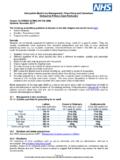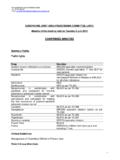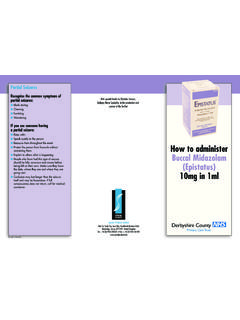Transcription of Derbyshire Community Dressing Formulary and Wound …
1 Wound Formulary Guidelines V1 Page 1 of 37 Derbyshire Community Dressing Formulary and Wound Care Guidelines 2016 Developed in Collaboration with East Midlands Tissue Viability Group Wound Formulary Guidelines V1 Page 2 of 37 TABLE OF CONTENTS Introduction .. 3 Traffic Light Key .. 4 Holistic Patient Assessment Should Include as a Minimum: .. 4 Objectives of Wound Management: .. 4 Wound Bed Assessment Should Include as a 4 Evaluations using .. 5 Tissue Type Present in a Wound Bed .. 6 Infection Inflamation .. 7 Antimicrobial Usage .. 7 Moisture Exudate Description .. 7 Edge .. 8 How to Order .. 9 Symbols used to ensure appropriate selection of Dressing products .. 9 Traffic Light Key .. 9 Wound Dressing Guidelines .. 10 1. Dressing Pack .. 10 2. Gauze 10 3.
2 Irrigation Solution .. 10 4. Tapes 10 5. Low Adherent dressings .. 11 6. Non-Adherent Primary 12 7. Vapour Permeable Adhesive Film Dressing .. 13 8. Hydrocolloids .. 14 9. Hydrogel .. 15 10. Foam Dressing .. 16 11. Alginates .. 18 12. Hydrofiber .. 19 13. Absorbent Dressing Pad .. 20 14. Super Absorbent Dressing .. 20 15. Specialist Silicone Foam Adhesive dressings .. 21 16. Non Bordered Soft Silicone Wound Super Absorbent Contact (Lot 10- 75%) .. 22 17. Odour Control dressings .. 23 18. Low Adherent Antimicrobials .. 24 19. Honey Dressing .. 25 20. Absorbent Antimicrobial 26 21. Iodine Based Antimicrobials .. 27 22. Silver Sulfadiazine cream FLAMAZINE (this requires prescription) .. 27 23. Surfactant .. 28 24. Retention Bandage Conforming Type 1 Dressing Retention (Lot 7 -100%) .. 28 25. Bandage Light Support Type 2 ( Lot 8 60%).
3 29 26. Type 2 Bandage Compression 4 Layer Component Parts Leg Ulcer (Direct 7 80%) .. 30 27. Tubular Bandage Conforming Type 1 Dressing Retention (Lot 9-100%) .. 30 28. Sub Compression Wool 31 29. Compression Bandages Compression Bandage Kits (Direct) .. 31 30. Zinc Paste Bandages .. 32 31. Skin Protection Barrier Creams and Films .. 33 32. Wound Manager Bags .. 33 33. Pressure Ulcer 33 Appendix 1 .. 35 Appendix 2 .. 36 Wound Formulary Guidelines V1 Page 3 of 37 INTRODUCTION The Derbyshire Wound Care and Dressing Formulary has been revised in collaboration with the East Midlands Wound Care Formulary Group. Work has been undertaken to provide a clinically effective, appropriate and cost effective choices of products to manage the vast majority of wounds. The Formulary is available for all practitioners working for Derbyshire Community Health Services and Primary Care Services.
4 It is expected that prescribers will preferentially use the products listed in the guide for routine use and be able to provide robust rationale where they have prescribed outside the Formulary . Wound Management groups including link nurses, ward nurses/ specialist nurses, district and practice nurses representing 18 Trusts within Derbyshire , Leicestershire, Northamptonshire and Nottinghamshire undertook a screening process to shortlist and evaluate a wide range of generic Wound care products for evaluations. In collaboration with NHS Supply Chain as well as individual Trust Procurement Teams, the evaluated products were entered into an e-auction and the Wound care companies were invited to provide best prices. The winners of these bids are the products that have been put on the Formulary and each Trust has agreed to switch their products in order to meet the agreed commitment level which was based on the previous year s NHS Supply orders.
5 It is recognised that there are many factors other than Dressing choice which influence Wound healing and as such a holistic approach to patient care must always be untaken. Before applying any Dressing the practitioner should assess the patient holistically and when reviewing the Wound determine any barriers to healing and discuss objectives of management with the patient and carer so that they can agree a management plan. Guidelines to Support This Formulary Wounds cause pain, discomfort and impact upon patient s lives, their management requires considerable resources in terms of treatment, products and staff time. The aim of the guidelines that support this Formulary is to promote effective Wound care through the promotion of a standardised approach to Wound assessment and reassessment using within the System one Template so that outcomes can be measured over time.
6 Wound Care Plans will often include a long term goal of promoting healing or management in line with symptom control, but in order to achieve these goals it is important to have clear short term objectives such as the need to rehydrate slough or necrosis in order to facilitate debridement. Or it may be that the fragile granulation tissue needs protection and thermal insulation. Or it may be that pain management or odour control is a priority in order to promote patient tolerance of treatment options. Defining Wound care objectives will assist staff in the selection of the most appropriate Dressing products to help achieve objectives. It is therefore important to have an awareness and understanding of the application and limitations of the various products within this Formulary .
7 Function of dressings The main function of any Dressing regimen is to maintain a moist (not saturated) Wound bed. (With the exception of wounds with stable eschar with no blood flow where a dry environment is required to minimise risks of infection) The balance of moisture control is achieved by using Wound management products to: Hydrate a dry Wound bed Maintain a moist Wound bed and prevent desiccation (drying out) Absorb excess Wound exudate to avoid maceration Fill dead space Infection/Bioburden management and prevention Debride non-viable tissue through autolysis Wound Formulary Guidelines V1 Page 4 of 37 TRAFFIC LIGHT KEY A traffic light key is been used to identify and categorise products into three categories. Products have been allocated to each category are based on cost effectiveness, staff familiarity, size/ shapes.
8 1ST Line Product Range 2nd line Range - Specialist Recommendation Holistic Patient Assessment Should Include as a Minimum: Past medical history Current and past drug therapies, allergies and dressings equipment treatment prior to admission Identification of factors which have the potential to increase the risk of non-healing or delayed healing; Refer to Wound Care Pathway (Appendix 1) Objectives of Wound Management: The Wound should be allowed to heal in a moist environment, unless the clinical goal is to maintain eschar in a dry and non-infected condition for example in the case of an ischaemic Wound the objective may be to protect the Wound conservatively until vascular status can be restored to facilitate potential for healing or it may be a dry gangrenous Wound where auto amputation is our objective.
9 The use of any Dressing in Wound care is of little limited value until factors that delay or inhibit Wound healing have been identified and addressed. Treatment and management regimes should address local symptoms to minimize complications and address or manage issues identified as part of holistic assessment. Wound Bed Assessment Should Include as a Minimum Type of Wound and aetiology of Wound Location of Wound - needs to be accurate in confirming anatomical location Size of Wound in mm- Use a disposal paper tape to record maximum length and width Use a sterile measuring probe to measure depth and extent of undermining Photography is a useful way of measuring when incorporating a rule or tape into the photograph so scale can be provided Description of the Wound bed using TIME, approximate percentage of presence of slough, necrosis, granular tissue, haematomas or exposed tendons or bone Description and volume of exudate Presence of infection, pain, malodour or foreign body.
10 State of surrounding skin and alterations in sensation. Ongoing assessment should be performed and provide evidence of Wound healing or deterioration in Wound healing. The timing of on-going re-assessment should be based on the Wound type, exudate management and individual patient factors. Within DCHS wounds should be reviewed weekly using Wound Care Pathway on System one or recorded in Wound assessment forms if using paper records. Wound Formulary Guidelines V1 Page 5 of 37 Evaluations using In order to evaluate the progress of a Wound and monitor the effectiveness of a management, DCHS has introduced the TIME acronym, consisting of tissue debridement, infection or inflammation, moisture balance and edge effect, this has been incorporated into the Wound care Pathway Template on system one so as to promote more frequent Wound progress reviews and monitor outcomes of care over time.









